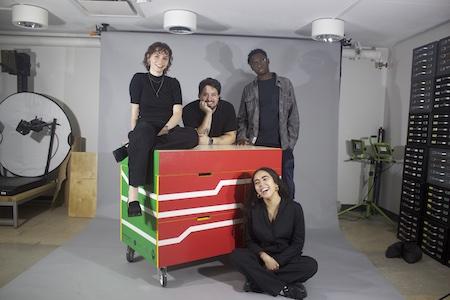
Spitzer Students and the mobile learning workstation they designed a for a local children’s hospital. Photo (from left): Evelyn Krutoy, Juan Giraldo, Mouhamadou Dieng, Gildalis Torres (seated), Miriam Perel (not pictured).
Bernard and Anne Spitzer School of Architecture students at The City College of New York under the advisement of Adjunct Professor Steve Preston designed a mobile learning workstation for a local children’s hospital. This work was completed as part of Freedom by Design (FBD), a community service program sponsored by the American Institute of Architecture Students (AIAS), that aims to solve everyday problems with modest design and construction solutions.
The student team included Juan Giraldo (director), Gildalis Torres (historian), Mouhamadou Dieng (construction manager), Evelyn Krutoy (construction editor), and Miriam Perel (treasurer).
The students were tasked with designing a cart for the hospital to facilitate hands-on education for parents. On a visit to the hospital, they recognized that the educators relied on tote bags to carry supplies between units and struggled to find family-friendly spaces for interactive teaching.
In response, the students designed a mobile workstation to function as both a transport vessel and learning platform. The station features several large drawers for equipment storage and a flat top surface for simulation-based teaching. The colorful exterior complements the pediatric unit’s subway décor theme and adds a playful touch to learning sessions.
Freedom by Design is the AIAS community service program in partnership with the National Council of Architectural Registration Boards (NCARB) and uses the talents of architecture students to impact the lives of people in their community through modest design and construction solutions.
FBD encourages students to serve their communities by addressing issues with design solutions and provides real-world experience through working with clients, learning from local licensed architects and contractors, and experiencing the practical impacts of architecture and design. The program embraces efforts to provide both design-build and engagement solutions to address five barriers: physical, educational, environmental, socio-economic and cultural.
The team has worked on the project since summer 2023. They have been designing and building the cart while periodically meeting with the hospital team, and this summer they finished construction and handed off the cart.
About The City College of New York
Since 1847, The City College of New York has provided a high-quality and affordable education to generations of New Yorkers in a wide variety of disciplines. CCNY embraces its position at the forefront of social change. It is ranked #1 by the Harvard-based Opportunity Insights out of 369 selective public colleges in the United States on the overall mobility index. This measure reflects both access and outcomes, representing the likelihood that a student at CCNY can move up two or more income quintiles. Education research organization Degree Choices ranks CCNY #1 nationally among universities for economic return on investment. In addition, the Center for World University Rankings places CCNY in the top 1.8% of universities worldwide in terms of academic excellence. Labor analytics firm Lightcast puts at $3.2 billion CCNY’s annual economic impact on the regional economy (5 boroughs and 5 adjacent counties) and quantifies the “for dollar” return on investment to students, taxpayers and society. At City College, more than 15,000 students pursue undergraduate and graduate degrees in eight schools and divisions, driven by significant funded research, creativity and scholarship. In 2023, CCNY launched its most expansive fundraising campaign, ever. The campaign, titled “Doing Remarkable Things Together” seeks to bring the College’s Foundation to more than $1 billion in total assets in support of the College mission. CCNY is as diverse, dynamic and visionary as New York City itself. View CCNY Media Kit.